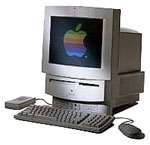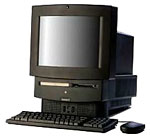I wonder how many PC users are still getting useful service out of
nine-year-old machines? I mean, the cusp of 1993-94 was still the early
days of the 486 chip, and Windows 3 was state of the art (so to speak)
in Microsoft system software.
The point of this musing is the upcoming ninth birthday of my old
Mac LC 520 all-in-one, which is
still in daily  use by my wife as her word
processing and email machine - tasks which it performs for her purposes
almost as satisfactorily as newer hardware would. In fact, she uses the
LC in preference to several faster and newer Macs in the house.
use by my wife as her word
processing and email machine - tasks which it performs for her purposes
almost as satisfactorily as newer hardware would. In fact, she uses the
LC in preference to several faster and newer Macs in the house.
The old LC has a 25 MHz 68030 chip and 20 MB of RAM. The original
160 MB Quantum hard drive is still going strong; it works quietly and
dependably. So does the dead-silent to 2x Sony CD-ROM drive, whose only
functional shortcoming is that it loads with a CD caddy, something
outside the experience of a lot of Mac users these days.
Everything still works on the old machine, although the floppy drive
is a bit cranky, having for the past couple of years refused to eject
discs without some help from a straightened paper clip inserted in the
handy emergency eject hole. It still reads and writes floppies fine,
however.
The 640 x 480 Sony Trinitron display is still sharp, bright, and
clear, and within its resolution limitations, is one of the nicest CRT
monitors I've ever used.
My wife uses Word 5.1 - the best piece of software Microsoft ever
made - Eudora Light 3.1.3 for email, and Netscape 4.04, which isn't
great, but she switches to one of our faster Macs for most Web surfing
anyway. On the other hand, the old LC has great serial port throughput
and gives nothing away to the later models in email performance through
a 28,800 bps US Robotics Sportster modem, which is still faster that
our crummy rural phone lines will support.
We're running System 7.5.5, but with the Open Transport software
from System 7.6.1 installed for dialup support. We had 7.6.1, the last
Mac OS version that supported the '030, installed for a short time, but
it seemed to offer no performance advantages and had compatibility
problems with our old Microtek scanner, so we downgraded to 7.5.5.
The LC is also the computer that stays hooked up to our ancient
ImageWriter II printer most of the time, and what little hard copy
printing I do is mostly handled through it and Word 5.1.
The old all-in-one also handles light-duty graphics work reasonably
well in Color It! 4.1,
still my all-time favorite graphics program, and indeed the one I still
use in Classic Mode running OS X on my PowerBook. It is, of
course, lightning fast on the G3, but it's no slouch on the LC - quite
an amazing testimony to backward and forward compatibility. I
understand that an OS X native port is in the works.
The LC 520 has been an amazingly forgiving and robust robust
computer. One of my favorite anecdotes about it is the time my son had
it dialled up to the Internet while he was working on an old Power Mac 9500 we had. He needed a
hard drive to test something he had repaired on the 9500, so without
bothering to shut down the LC or even a log off the Net, he popped the
Quantum hard drive out of its easily accessible bay in the back of the
520, did what he needed to do with it, and then reinserted it in the
LC, which had remained running and dialled up to the Internet
throughout.
Not only is the LC's hard drive easily accessible, but the
motherboard slides out of a hatch in the back like pulling a drawer out
in a cabinet, making things like RAM upgrades or PRAM battery
replacement a breeze. One of Apple's better ideas.
The LC was a good and faithful workhorse computer for me for three
years. It would not even be remotely adequate as a production machine
now - the computer world has progressed too far in the subsequent six
years. However, it is still a tribute to be the essential goodness of
the Mac OS concept, not to mention the robustness of Apple hardware,
that this old computer at nine years of age is still not only useful,
but that the user interface paradigms it employs are not all that
radically different from the ones in Apple's new generation OS.
I wish I had more confidence that my current Pismo PowerBook will still be
running, let alone useful, in seven years time. On the other hand, the PowerBook 5300 that superseded LC 520 as
my number one computer is still going strong well into its seventh
year, now in the hands of my daughter, and I would guess that it has
twice the hours on at that has the LC does.
The LC 520 was built for seven months - June 1993 to February 1994 -
and then replaced by the short-lived (production wise) LC 550, which
was pretty much identical save for a slightly faster 33 MHz '030 chip.
There were also Performa versions of these machines that shipped with
keyboards, mice, and bundled software, including the Performa 560, the
"Money magazine edition" that came bundled with personal finance
software.
Another variant was the Macintosh
TV in this form factor, but with a very cool black case and
matching  keyboard, mouse, and remote-control - and
an internal TV tuner. Unfortunately, this configuration was limited to
a maximum 8 MB of RAM. The Mac TV had a 33 MHz '030 chip.
keyboard, mouse, and remote-control - and
an internal TV tuner. Unfortunately, this configuration was limited to
a maximum 8 MB of RAM. The Mac TV had a 33 MHz '030 chip.
In November 1994, the LC 550 was superseded by the LC 575 (Performa 575, 577, 578) which
replaced the old 33 MHz '030 with a 68LC040 chip running at 33 MHz, had
a 250 MB hard drive, and added a "Communications Slot" that could
except an ethernet card or an internal fax/modem. The LC 550 and later
also dispensed with the 520's rock-solid and silent running Sony 2x
caddy-loading CD-ROM drive, and replaced it with a more convenient -
but unfortunately much less reliable - Matsushita tray-loading 2x
drive.
The final edition of the all-in-one 5xx series was the LC 580 (Performa 580, 588), which was sort
of to the modular LC/Quadra/Performa 630 what the LC 520 had been to
the LC III, and the LC 575 had
been to the LC 475/Quadra 605. It
was also the last 68k desktop Mac marketed (at least in Canada). The
58x model retained the 57x's 33 MHz '040 chip, but Apple replaced the
lovely Trinitron with a cheaper, grainier, less flat monitor, and the
SCSI hard drive gave way toh a cheaper, higher capacity 500 or 800 MB
IDE drive.
The 58x also had two RAM upgrade slots. Some of the Macintosh TV's
functionality was incorporated in an optional TV tuner, and standard
RAM was upgraded to 8 MB, with a maximum RAM of 52 MB.
Want a piece of Mac history? At this writing, Shreve Systems, which is winding
down operations, is still advertising some new LC 580s at fire
sale prices: LC 580 new in box, incl. ClarisWorks. With CD-ROM, $75. No
CD-ROM, $50.

 use by my wife as her word
processing and email machine - tasks which it performs for her purposes
almost as satisfactorily as newer hardware would. In fact, she uses the
LC in preference to several faster and newer Macs in the house.
use by my wife as her word
processing and email machine - tasks which it performs for her purposes
almost as satisfactorily as newer hardware would. In fact, she uses the
LC in preference to several faster and newer Macs in the house. keyboard, mouse, and remote-control - and
an internal TV tuner. Unfortunately, this configuration was limited to
a maximum 8 MB of RAM. The Mac TV had a 33 MHz '030 chip.
keyboard, mouse, and remote-control - and
an internal TV tuner. Unfortunately, this configuration was limited to
a maximum 8 MB of RAM. The Mac TV had a 33 MHz '030 chip.
